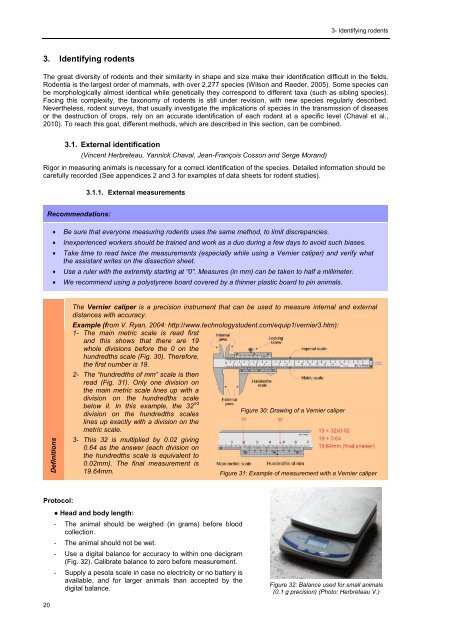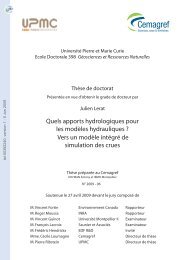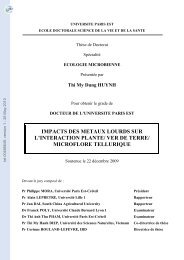Protocols for field and laboratory rodent studies - HAL
Protocols for field and laboratory rodent studies - HAL
Protocols for field and laboratory rodent studies - HAL
- No tags were found...
Create successful ePaper yourself
Turn your PDF publications into a flip-book with our unique Google optimized e-Paper software.
Definitions3- Identifying <strong>rodent</strong>s3. Identifying <strong>rodent</strong>sThe great diversity of <strong>rodent</strong>s <strong>and</strong> their similarity in shape <strong>and</strong> size make their identification difficult in the <strong>field</strong>s.Rodentia is the largest order of mammals, with over 2,277 species (Wilson <strong>and</strong> Reeder, 2005). Some species canbe morphologically almost identical while genetically they correspond to different taxa (such as sibling species).Facing this complexity, the taxonomy of <strong>rodent</strong>s is still under revision, with new species regularly described.Nevertheless, <strong>rodent</strong> surveys, that usually investigate the implications of species in the transmission of diseasesor the destruction of crops, rely on an accurate identification of each <strong>rodent</strong> at a specific level (Chaval et al.,2010). To reach this goal, different methods, which are described in this section, can be combined.3.1. External identification(Vincent Herbreteau, Yannick Chaval, Jean-François Cosson <strong>and</strong> Serge Mor<strong>and</strong>)Rigor in measuring animals is necessary <strong>for</strong> a correct identification of the species. Detailed in<strong>for</strong>mation should becarefully recorded (See appendices 2 <strong>and</strong> 3 <strong>for</strong> examples of data sheets <strong>for</strong> <strong>rodent</strong> <strong>studies</strong>).3.1.1. External measurementsRecommendations:Be sure that everyone measuring <strong>rodent</strong>s uses the same method, to limit discrepancies.Inexperienced workers should be trained <strong>and</strong> work as a duo during a few days to avoid such biases.Take time to read twice the measurements (especially while using a Vernier caliper) <strong>and</strong> verify whatthe assistant writes on the dissection sheet.Use a ruler with the extremity starting at “0”. Measures (in mm) can be taken to half a millimeter.We recommend using a polystyrene board covered by a thinner plastic board to pin animals.The Vernier caliper is a precision instrument that can be used to measure internal <strong>and</strong> externaldistances with accuracy.Example (from V. Ryan, 2004: http://www.technologystudent.com/equip1/vernier3.htm):1- The main metric scale is read first<strong>and</strong> this shows that there are 19whole divisions be<strong>for</strong>e the 0 on thehundredths scale (Fig. 30). There<strong>for</strong>e,the first number is 19.2- The “hundredths of mm” scale is thenread (Fig. 31). Only one division onthe main metric scale lines up with adivision on the hundredths scalebelow it. In this example, the 32 nddivision on the hundredths scaleslines up exactly with a division on themetric scale.3- This 32 is multiplied by 0.02 giving0.64 as the answer (each division onthe hundredths scale is equivalent to0.02mm). The final measurement is19.64mm.Figure 30: Drawing of a Vernier caliperFigure 31: Example of measurement with a Vernier caliperProtocol:● Head <strong>and</strong> body length:- The animal should be weighed (in grams) be<strong>for</strong>e bloodcollection.- The animal should not be wet.- Use a digital balance <strong>for</strong> accuracy to within one decigram(Fig. 32). Calibrate balance to zero be<strong>for</strong>e measurement.- Supply a pesola scale in case no electricity or no battery isavailable, <strong>and</strong> <strong>for</strong> larger animals than accepted by thedigital balance.Figure 32: Balance used <strong>for</strong> small animals(0.1 g precision) (Photo: Herbreteau V.)20
















